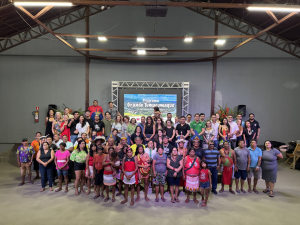The program is scheduled to last 15 years and will include local indigenous peoples and organizations, as well as contributing to territorial protection, monitoring biodiversity and tackling the climate crisis.

On November 8, the Iepé Institute, Imazon, the Apitikatxi, Apiwa and Tekohara Indigenous Associations, Funai and Ideflor-bio welcomed guests and partners to an event marking the start of the Grande Tumucumaque Program.
The program aims to support the implementation of Management Plans for Conservation Units and Territorial and Environmental Management Plans for Indigenous Lands (PGTAs), as well as strengthening alliances between indigenous peoples and other neighboring peoples and conservation units that make up the largest corridor of protected areas in the world. The Grande Tumucumaque Program is planned to cover 15 years with funding from the Legacy Landscapes Fund and co-financing from Nia Tero.
“Iepé has been working in partnership with indigenous organizations for more than two decades. Over the next 15 years, we will continue to implement the Territorial and Environmental Management Plans (PGTAs) developed by these peoples. So, together we hope to contribute to the well-being of future generations. Year after year, the PGTAs consolidate themselves as tools for new achievements and new partnerships,” says Denise Fajardo, coordinator of the Tumucumaque-Wayamu Program at the Iepé Institute.
About the region
Grande Tumucumaque is located in the north of Pará State, on Brazil’s border with French Guiana and Suriname. The area encompasses two conservation units (the Maicuru State Biological Reserve and the Grão Pará State Ecological Station) and three indigenous lands (Parque do Tumucumaque, Rio Paru d’Este and Zo’é).
Altogether, it covers more than 103,000 km², one of the most biodiverse areas on the planet and home to several endangered species and endemic species (those that only occur in a particular place). For this reason, its protection is essential for the conservation of the Amazon.
Due to its territorial extension of standing forest, the Greater Tumucumaque region is of extreme national and international importance for climate balance, as it functions as a major carbon storage. In addition, due to the number of species that only occur there, such as a type of golden woodpecker, the saium monkey, some species of tree frog and climbing plants, it is considered a ‘center of endemism’, which reinforces the need for actions to monitor and conserve biodiversity,” explains researcher and director of Imazon’s Protected Areas Program, Jakeline Pereira.
Program launch event
Alongside the launch of the Grande Tumucumaque Program, indigenous peoples from the region gave cultural presentations and there was a panel discussion with representatives of the organizations involved. Among the topics of debate were territorial protection and biodiversity monitoring.
“This program is a historic achievement. In 20 years of Apitikatxi, we have always been searching for partnerships and resources. It’s been a long road, we’ve worked hard to get here. It’s a 15-year program that will support the implementation of our PGTA and many good things will come of it,” says Aventino Tiriyó Kaxuyana, president of Apitikatxi (Association of Tiriyó, Kaxuyana and Txikiyana Indigenous Peoples).
” The program represents hope for us and for our territory. The 15-year duration means that our demands will have time to be met. It’s a satisfaction for us,” says Arinaware Apalai Wayana, president of Apiwa (Association of Wayana and Apalai Indigenous Peoples).
“The Grande Tumucumaque Program brings together various partners, but the most important thing is the self-determination of the indigenous peoples. It is essential that they are autonomous, protagonists of their struggles. We’re not just talking about forests, but about people and the biodiversity that lies within them. The Grande Tumucumaque Program is preparing for today, but looking to the future,” says Nara Baré, director of Nia Tero in Brazil.
The November 8 event also saw the announcement of the project “Arts of the Txama Txama: Documenting Our Practices and Knowledge, Safeguarding Our Ways of Life”, which will be supported by the National Historical and Artistic Heritage Institute. (Iphan).
About the alliance organizations:
Iepé – Instituto de Pesquisa e Formação Indígena (Institute for Indigenous Research and Training) is a non-governmental, non-profit organization founded in 2002. Its mission is to contribute to the cultural, political and sustainable development of indigenous communities in the Brazilian territories located in Amapá and northern Pará. Its aim is to strengthen forms of community and collective management, so that the rights of these peoples are respected.
The Amazon Institute of People and the Environment (Imazon) is an Amazonian scientific institution whose mission is to promote conservation and sustainable development in the Amazon. To this end, it carries out research and field projects to produce and apply nature-based solutions to improve the quality of life not only of the Amazonian population, but also of Brazil and the world.
Legacy Landscapes Fund (LLF) is an international public-private fund, established as an independent charitable foundation in 2020, with the aim of supporting nature, people and the climate.
Nia Tero is a US-based non-profit organization that works in solidarity with indigenous peoples around the world to support their efforts to protect their territories.
The Association of Tiriyó, Katxuyana and Txikuyana Indigenous Peoples (Apitikatxi) was founded in 2004 and is run by the indigenous peoples of the western side of the Parque do Tumucumaque Indigenous Land.
The Association of Wayana and Aparai Indigenous Peoples (Apiwa) was founded in 2010 and is run by the indigenous peoples of the eastern side of the Parque do Tumucumaque Indigenous Land and the Rio Paru D’este Indigenous Land.
The Tekohara Association is an association founded and managed by the Zo’é indigenous peoples who live in the Zo’é Indigenous Land.
The National Foundation for Indigenous Peoples (FUNAI) is the official indigenous agency in Brazil.
Ideflor-bio is the Forestry and Biodiversity Development Institute of the State of Pará.
Contact for the press:
João Bourroul (Instituto Iepé): (11) 95000-3543
Daisy Feio (Imazon) : (91) 99377-2595
